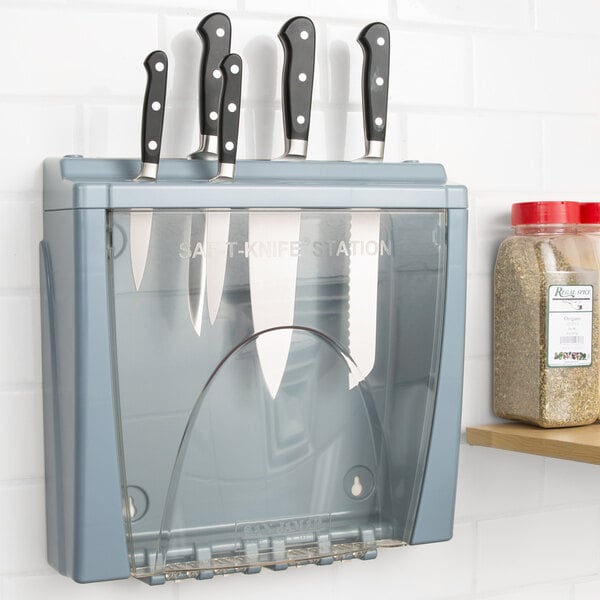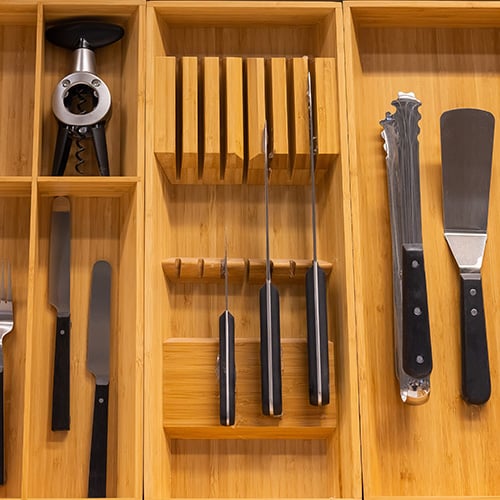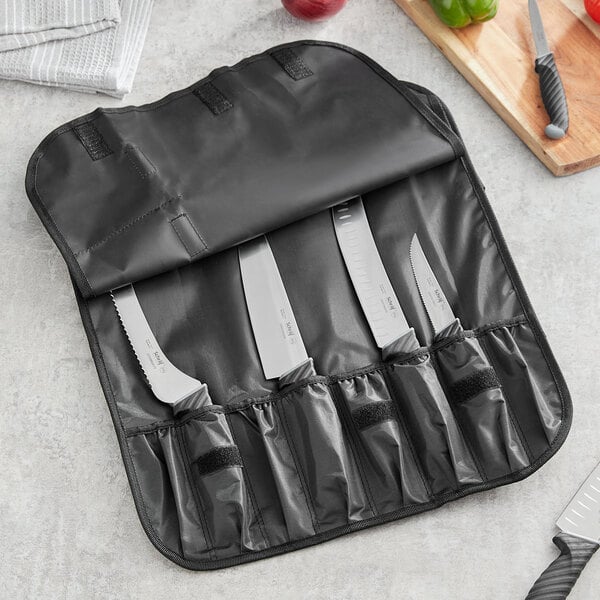Knives are essential in any commercial kitchen, serving multiple purposes ranging from slicing and dicing to chopping and mincing. Properly storing knives is crucial for maintaining their sharpness and longevity and ensuring the safety of your kitchen staff. By implementing effective knife storage practices, you can keep your knives organized, accessible, and in top condition for daily use. We will explore the importance of proper knife storage and provide practical tips on how to store knives safely and efficiently in a commercial kitchen setting.
Shop All Knife Racks and Holders
Best Way to Store Knives

The best way to store knives is using a knife rack, which offers unparalleled accessibility, organization, and protection for your blades and staff. A knife rack is designed to hold multiple knives securely and within easy reach but keeps the blades covered to ensure safety and hygiene. Typically wall-mounted or freestanding, knife racks offer designated slots or hooks for each knife and securely hold them in place. The clear visibility and orderly arrangement of knives on a rack streamline workflow, enhancing efficiency in busy commercial kitchens.
Pros
- Provide immediate access to knives
- Open design for increased visibility and prevent bacteria growth
- Keeps knives organized on designated hooks or slots
- Wall-mounted options to save counterspace
- Individual slots protect blades from damage
Cons
Other Types of Knife Storage
There are six primary types of knife storage besides knife racks, each with unique advantages and challenges. The best option for you depends on your day-to-day operations, your kitchen space and design, and the mobility of your business.
1. Knife Block

A knife block is a classic and widely used method for storing kitchen knives, but it tends to be more residential than commercial. Typically made from wood, bamboo, or plastic, knife blocks feature slots or openings where the blades are inserted, keeping the knives organized and within easy reach. Though it's a convenient storage option, it lacks the flexibility of a magnetic strip or knife roll. Additionally, knife blocks can dull the knives and create sanitation concerns if cleaned improperly.
Pros
- Keeps knives neatly arranged and easily accessible
- Creates a specific place for knives to reduce the risk of misplaced tools
- Protect knives from exposure and protect staff from accidental cuts
Cons
2. Magnetic Knife Block

Unlike traditional knife blocks with slots, magnetic knife blocks use strong magnets embedded within a wooden or plastic block to keep knives in place. Knives are attached to the surface of the block, providing convenience, aesthetics, and space efficiency. However, regular maintenance and careful placement are crucial to ensure safety and hygiene in a busy commercial kitchen.
Pros
- Quick and easy access to knives
- Reduces risk of blade damage and dulling during storage
- Magnets keep knives secure to prevent accidental cuts
- Aesthetic
- More compact than traditional knife blocks
Cons
3. Magnetic Knife Strip

A magnetic knife strip is a versatile and space-saving storage solution that mounts on the wall, using strong magnets to securely hold knives in place. These strips are typically made of stainless steel or wood and provide an efficient way to organize and display knives while keeping them easily accessible. Though they offer a practical and stylish way to store knives while maximizing available workspace, ensure they are regularly cleaned and checked for stability to ensure safety.
Pros
- Free up valuable counter and storage space
- Quick and easy access to the right tool when needed
- Promotes organization and workflow
- Keeps blades sharp by minimizing contact with other surfaces
- Aesthetic
Cons
4. Drawer Knife Block

A drawer knife block is a storage solution designed to fit inside a kitchen drawer, keeping knives organized and out of sight. These blocks come in various configurations, often made from wood, bamboo, or plastic, with slots or compartments to securely hold each knife. This option combines convenience with safety, making it popular in many commercial kitchens.
Pros
- Frees up counterspace and keeps workspaces uncluttered
- Reduces risk of accidental cuts or injuries
- Keeps knives neatly organized
- Protect blades from other utensils or airborne contaminants
Cons
5. Knife Roll

A knife roll is a portable storage solution designed for chefs and culinary professionals who need to transport their knives and tools easily. Typically made from durable materials like canvas, leather, or nylon, knife rolls feature individual slots or pockets for each knife, allowing them to be rolled up and secured with straps or buckles. This versatile option combines functionality with mobility, making it a favorite among traveling chefs and those who work in multiple locations.
Pros
- Convenient way to transport knives
- Saves space in a suitcase
- Each knife has its own slot or pocket, preventing contact with other blades
- Padding protects knives during transport
- Keeps knives organized
Cons
6. Edge Guard or Sheath

Edge guards and sheaths protect your blades when stored alongside other utensils in a box or drawer. Made from durable plastic, silicone, or rubber, edge guards slide over the knife's blade, covering the sharp edge. Knife sheaths fully encase the blade and often part of the handle, while edge guards focus solely on the blade's cutting edge for a more compact solution. Both options offer practical, space-saving, and cost-effective ways to protect knife blades.
Pros
- Shields blades from nicks, dulling, and damage
- Keeps blade protected during transport
- Compact design
- Allows knives to be stored with other utensils
- Accommodates different brands and styles
- Cost-effective
Cons
Knife Storage Tips
Proper knife storage is essential for maintaining the longevity and performance of your blades in a busy commercial kitchen. Ultimately, knife storage relies on correct cleaning and drying procedures to prolong the longevity of your knives. Here are some practical tips to help you store knives safely and effectively:
- Always thoroughly clean and dry knives before storing them to prevent rust and bacterial growth.
- Organize knives by size and use to streamline kitchen operations. Keep commonly used knives easily accessible and store specialty knives separately.
- Do not overcrowd storage solutions, as this can lead to blades rubbing against each other, causing nicks and dulling.
- Clean and maintain storage units regularly to ensure they remain hygienic and functional. During this process, inspect them for signs of wear, damage, or contamination.
- Prioritize knife safety when choosing a storage option. Use edge guards for additional protection, and keep knives out of high-traffic areas.
- Label specialty knife storage slots to avoid confusion and ensure proper use.
Flying with Chef Knives
Knives are permitted in your checked bag if they're sheathed or securely wrapped to prevent injury to bag inspectors. Though you don't have to declare your chef knives in the US, your bag is subject to search and potential confiscation of dangerous goods. If you're storing knives for travel, check with your airline for their specific regulations regarding flying with knives.
Use one of the following portable knife storage options to properly pack your knives before putting them in your bag.
- Knife roll: Ideal for frequent travelers flying with multiple chef knives who need to save space.
- Edge guards or sheath: Ideal for infrequent travelers carrying low and mid-cost single knives.
- Knife case: Ideal for travelers with high-end knives that need extra protection.
- Wrapping and bundling: Ideal for travelers with a miscellaneous knife set seeking to save money.
Whether you have a permanent kitchen or travel between venues, proper knife storage protects your blades from harm and keeps them ready for use. Whether you choose a knife block, magnetic strip, or knife case, select a storage solution that fits your kitchen layout and knife collection. Don't forget to clean and dry your knives before storing them, and avoid overcrowding to prevent blade damage.



